Robert Venditti Takes on the “Ratzis” in Freedom Fighters
Artist Eddy Barrows Joins the Hawkman Writer for a New DC Comics Maxi-Series
Main Art by Eddy Barrows, Eber Ferreira & Adriano Lucas Comics Features Robert Venditti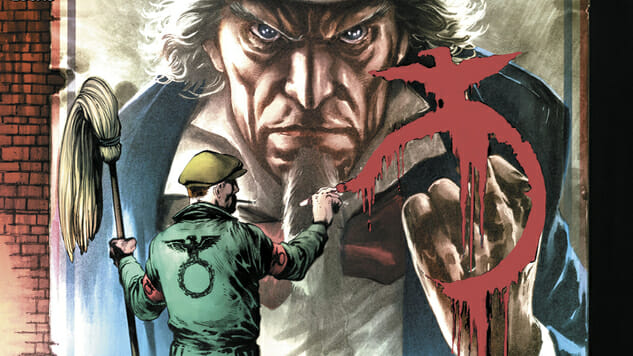
Grant Morrison’s The Multiversity introduced or updated dozens of alternate worlds and countless potential characters over the span of nine issues in 2014 and 2015, but very little of that project’s boundless creativity bled over into the wider DC Comics universe. That all changes this week thanks to the launch of Robert Venditti and Eddy Barrows’ Freedom Fighters, a 12-issue maxi-series expansion of the team as imagined in Morrison and Jim Lee’s Mastermen issue.
Taking a page from former iterations of the Freedom Fighters, this crew of patriotic heroes exists in a world where the Nazis emerged triumphant from WWII, and still maintain control of the United States decades later. Some of the Freedom Fighters we met in that one-shot apparently didn’t survive the explosive climax, but new rebels have stepped up to fight back against the Hitler dynasty.
Venditti, formerly of Valiant’s X-O Manowar and DC’s own Green Lantern, has found ample success untangling Hawkman as of late, while Barrows’ work throughout the New 52 and Rebirth eras has established him among the top of DC’s artistic pack. It’s great to see a Multiversity concept springing out into its own book, but if nothing else, we’re just happy to see superheroes fighting Nazis.
In advance of Freedom Fighters #1, which hits stands and digital retailers today, Paste exchanged emails with Venditti to get the rundown on the new cast, find out what it’s like to imagine Hitler’s America in 2018 and try to ferret out some upcoming Hawkman teases while we had his attention.
![]()
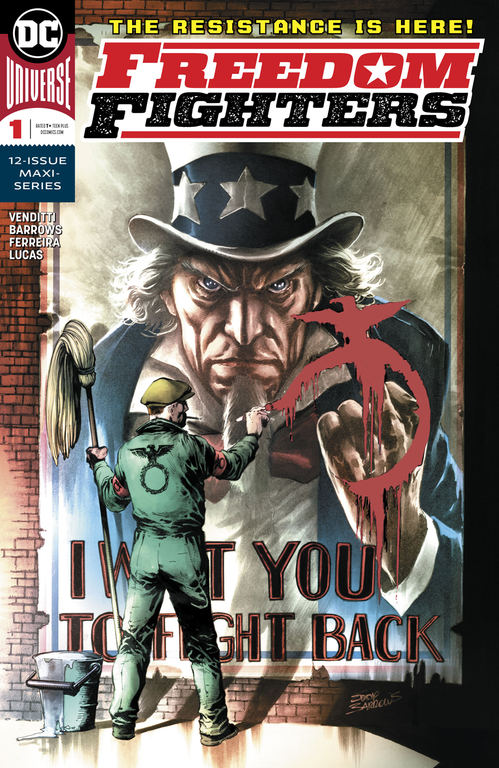
Freedom Fighters #1 Cover Art by Eddy Barrows, Eber Ferreira & Adriano Lucas
Paste: Let’s get the loaded question out of the way first—an America overrun by Nazis and fascists is all too easy to imagine in 2018, even if it felt unthinkable just a few short years ago. How are you threading the needle between saying something important about the subject matter and crafting an entertaining superhero story? Has this been a more difficult undertaking than some of your other DC stories?
Robert Venditti: It has been more difficult, but not in the way you might think. I came to this story from a different angle. When DC approached me about writing a Freedom Fighters series set on Earth X, the alternate DC Universe Earth where Nazi Germany won World War II, I was already working on Six Days, my original graphic novel with Kevin Maurer, Andrea Mutti and Lee Loughridge. Based on the Battle of Graignes, during which my uncle was killed as part of the D-Day campaign, I’d been spending a lot of time thinking about the sacrifices so many made to defeat the Third Reich. It’s been an emotional project, not just because of how it has led me to delve into that history, but also because of what the loss of my uncle meant to my family.
Six Days will be released May 14, 2019, just before the 75th anniversary of D-Day. At the same time, Freedom Fighters will be midway through its run. Thematically, they’re very much companion pieces. Six Days considers the world we have because of the sacrifices that were made. Freedom Fighters considers the world we’d have if those sacrifices hadn’t been made.
Paste: What kind of research or reference has gone into imagining a world dominated by the Third Reich? Did any other stories or real-life accounts particularly influence your take on this “Ratzi”-infected America?
Venditti: The Battle of Graignes was a tragic event. After the battle was over, American soldiers and French civilians were executed. The village was almost completely burned. That’s the headspace I was already in as I took on Freedom Fighters. It’s about envisioning the worst that humanity can be and putting it on the page. It isn’t a comfortable place to be. I get sad. I get angry. These aren’t fictional villains clad in costumes. They’re Nazis. My uncle died fighting Nazis. It’s all very real.
But then I get to write scenes with Uncle Sam or this new team of Freedom Fighters, and suddenly fiction has power over the real. That’s an absolutely wonderful place to be.
No matter how dark times may seem, there will always be heroes who’ll inspire us and lead us back to our better selves. I firmly believe that.
Paste: In this first issue, we get to meet both the original Freedom Fighters (or what’s left of them) and the folks who pick up their mantles decades later. What can you tell us about this new squad of patriotic heroes, and how they might differ from previous iterations of the team? Are these the same characters we met in the Mastermen issue of Multiversity?
Venditti: Except for Human Bomb, these are the same characters who we saw briefly at the end of the Multiversity: Mastermen issue. We have a different Human Bomb because that one was killed when the New Reichsmen’s satellite base crashed to Earth. As we find out in the series, The Ray and Doll Man were also killed, leaving us with our core cast of Black Condor, Phantom Lady, Doll Woman, Human Bomb and one new addition, Cache, the pilot of the new Blue Tracer.
We’re creating a back-story and motivations for each of them. Black Condor grew up in a city-sized factory where minorities are forced into hard labor to keep the Nazi manufacturing machine churning. He built a set of wings from scrap metal and escaped over the 100-yard wall, but now carries the guilt over everyone he left behind. Phantom Lady is the daughter of a Nazi lawyer who wrote the laws that are used to keep minorities subjugated. Now she wants to tear down that legal system by any means necessary. Human Bomb is the last living relative of the original Golden Age Human Bomb, making him the only one who could survive ingesting the formula that grants him his powers. He joined the team because he didn’t have a choice. Doll Woman’s husband was killed by the Nazis. All she wants is payback.
They’ve all joined together to bring back Uncle Sam and start a new American Revolution. The Hitler dynasty is to blame for their own worst enemies.
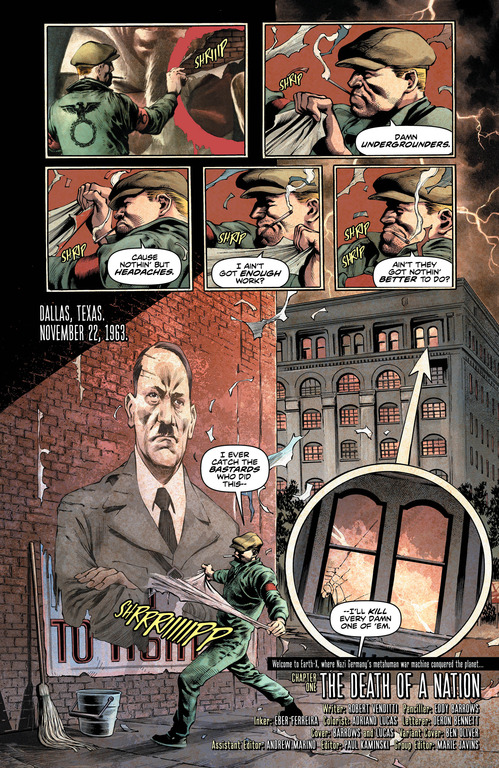
Freedom Fighters #1 Interior Art by Eddy Barrows, Eber Ferreira & Adriano Lucas
Paste: One notable Freedom Fighter mentioned in the issue, but who doesn’t actually appear on the page, is The Ray. Grant Morrison and Jim Lee’s reinvention of the character in Multiversity established him as one of the DCU’s few gay male heroes, a trait that carried over to his main-universe equivalent. Does The Ray have a role to play in your Freedom Fighters series, or will you be focusing on the cast seen in this issue?
Venditti: As you mentioned, The Ray has already appeared in Justice League of America, and DC wanted to avoid the confusion that can occur from multiple versions of the same hero. The same holds true for other Quality Comics characters—Plastic Man, for example—who’ve been appearing in the main DC universe. The characters we’re using aren’t appearing anywhere else.
Paste: The main foot soldiers we meet in the first issue are the PlaSStic Men, a Nazi perversion of Eel O’Brien’s Plastic Man. Can you tease some of the other funhouse-mirror versions of familiar DC faces we may see as the series progresses?
Venditti: The PlaSStic Men are the Hitler dynasty’s ultimate SS infiltrators, a shape-shifting force of secret police engineered from Eel O’Brien’s remains. Every aspect of their appearance is part of their uniform, including their matching blue eyes and blonde hair. But when they’re in action, they can take the form of anyone or anything. The PlaSStic Men are always watching.
We’re also going to meet the Iron Police, a.k.a. “Bozos”—our version of Bozo the Iron Man—reimagined as giant, robotic soldiers who function like walking tanks. There’s a War Wheel. And there’s Overman, of course, but even he may not be what he seems. We don’t stop there. One of our goals with Freedom Fighters is reimagining familiar characters in chilling, surprising ways.
Paste: Eddy Barrows renders the PlaSStic Men with distorted menace, and gets to tackle everything from miniaturized gore to big patriotic splashes in this first issue. What can you tell us about Barrows’ contribution to Freedom Fighters, and how you’ve worked together to create the look and feel of this alternative DCU?
Venditti: Freedom Fighters is an enormously complex series. It’s a team book featuring a new cast of characters, set in a world where society looks and operates differently from our own.
This is world-building in its fullest sense. We’re creating everything from the ground up. It’s far easier and less labor intensive for a writer to type up ideas and concepts than it is for an artist to render them visually. The amount of detail and imagination Eddy is putting into this series, coupled with his skill at drawing both big action and small human emotion, is stunning. And he never lets up. He’s drawn two versions of the Freedom Fighters team, 1960s America and the present day, swarms of PlaSStic Men, a giant tank robot, a group of kids playing an innocent game of catch and an attack on a Nazi war museum.
That’s just in the first issue.
Paste: Switching gears just a bit—Hawkman has celebrated the character’s infamously entangled continuity in very easy-to-understand ways. With the character’s past playing such an important role in his future, what can you reveal about Hawkman’s next arc? And is it too early to start prying about what Doomsday Clock’s JSA revelations have in store for the winged hero?
Venditti: It’s too early to talk about those things, but rest assured there’s a plan in place. Carter Hall will arrive at the end of the first year of the series a different man and a different hero than where he began. The secrets of his past will be revealed to him, and they aren’t all good. That conflict will take him to some terrifying places. Bryan Hitch and I have several things we want to accomplish with Hawkman, and one of them is to return this classic character to a role of central importance in the DC Universe. Reincarnating across time and space has made Carter Hall a living historical document. He has been a witness, and in some cases an engine, of history. The same holds true for the present and future as well.
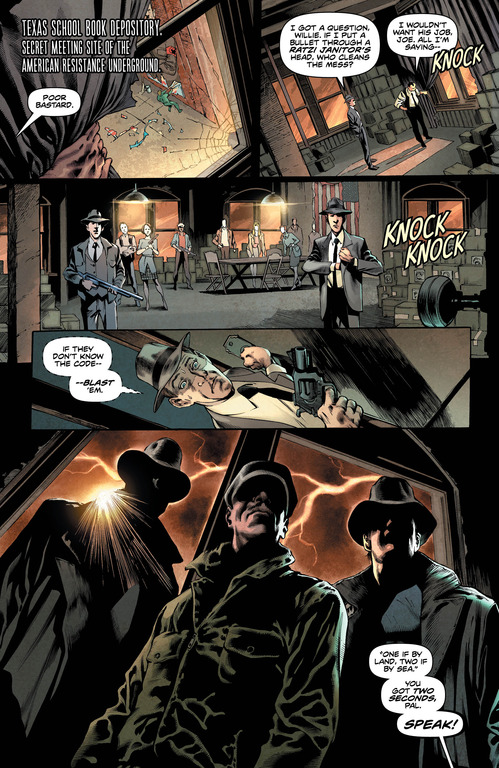
Freedom Fighters #1 Interior Art by Eddy Barrows, Eber Ferreira & Adriano Lucas

Freedom Fighters #1 Interior Art by Eddy Barrows, Eber Ferreira & Adriano Lucas

Freedom Fighters #1 Interior Art by Eddy Barrows, Eber Ferreira & Adriano Lucas
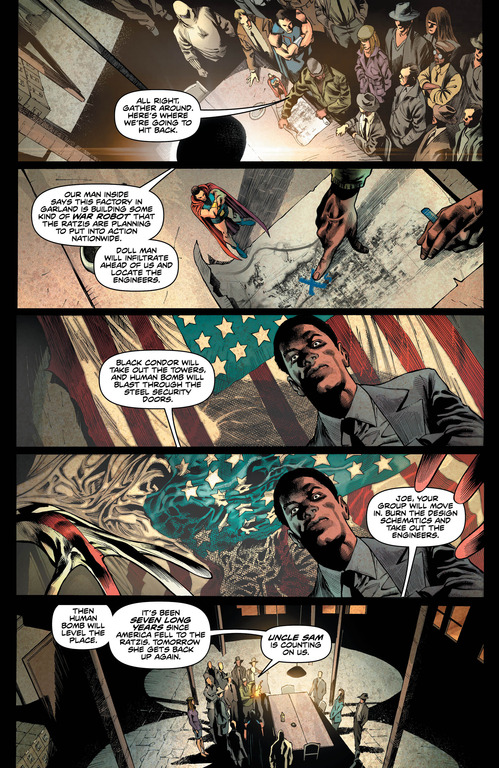
Freedom Fighters #1 Interior Art by Eddy Barrows, Eber Ferreira & Adriano Lucas
